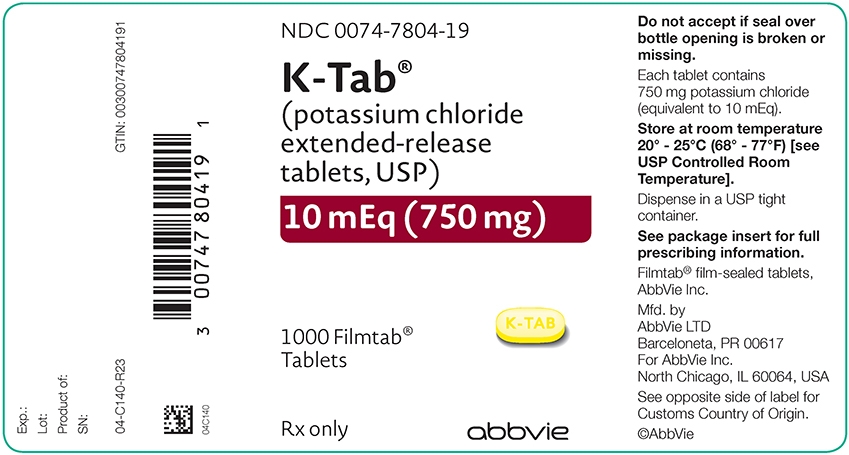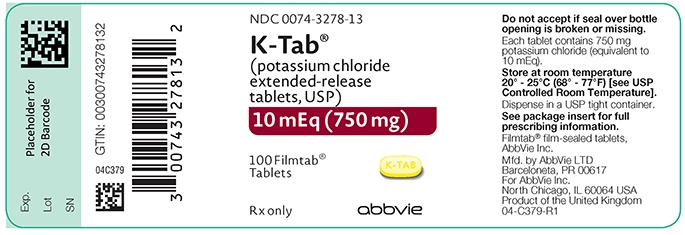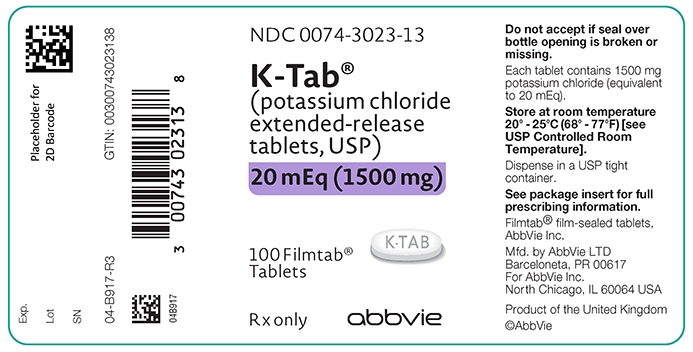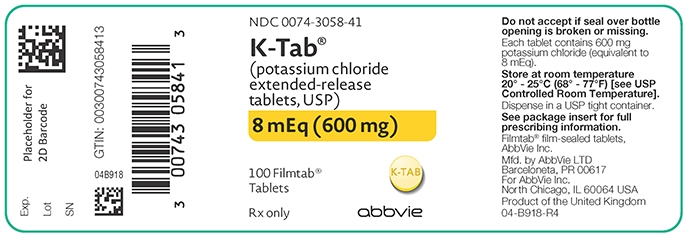K-TAB- potassium chloride tablet, film coated, extended release
K-Tab by
Drug Labeling and Warnings
K-Tab by is a Prescription medication manufactured, distributed, or labeled by AbbVie Inc.. Drug facts, warnings, and ingredients follow.
Drug Details [pdf]
-
HIGHLIGHTS OF PRESCRIBING INFORMATION
These highlights do not include all the information needed to use K-TAB safely and effectively. See full prescribing information for K-TAB.
K-TAB (potassium chloride) extended-release tablets, for oral use
Initial U.S. Approval: 1948INDICATIONS AND USAGE
K-TAB is a potassium salt indicated for the treatment and prophylaxis of hypokalemia with or without metabolic alkalosis in patients for whom dietary management with potassium-rich foods or diuretic dose reduction is insufficient. (1)
DOSAGE AND ADMINISTRATION
- Monitor serum potassium and adjust dosages accordingly (2.1)
- If serum potassium concentration is less than 2.5 mEq/L, use intravenous potassium instead of oral supplementation (2.1)
- Take with meals and with a glass of water or other liquid. Swallow tablets whole. (2.1)
- Treatment of hypokalemia: Typical dose range is 40-100 mEq per day in divided doses. Limit doses to 20 mEq per dose. (2.2)
- Prevention of hypokalemia: Typical dose is 20 mEq per day (2.2)
DOSAGE FORMS AND STRENGTHS
WARNINGS AND PRECAUTIONS
- Gastrointestinal Adverse Reactions: Can produce ulcerative and/or stenotic lesions of the gastrointestinal tract, particularly when in prolonged contact with the gastrointestinal mucosa. Take with meals. (5.1)
ADVERSE REACTIONS
Most common adverse reactions are nausea, vomiting, flatulence, abdominal pain/discomfort, and diarrhea (6)
To report SUSPECTED ADVERSE REACTIONS, contact AbbVie Inc. at 1-800-633-9110 or FDA at 1-800-FDA-1088 or www.fda.gov/medwatch.
DRUG INTERACTIONS
USE IN SPECIFIC POPULATIONS
See 17 for PATIENT COUNSELING INFORMATION.
Revised: 4/2018
-
Table of Contents
FULL PRESCRIBING INFORMATION: CONTENTS*
1 INDICATIONS AND USAGE
2 DOSAGE AND ADMINISTRATION
2.1 Monitoring and Administration
2.2 Dosing
3 DOSAGE FORMS AND STRENGTHS
4 CONTRAINDICATIONS
5 WARNINGS AND PRECAUTIONS
5.1 Gastrointestinal Adverse Reactions
6 ADVERSE REACTIONS
7 DRUG INTERACTIONS
7.1 Triamterene and Amiloride
7.2 Renin-Angiotensin-Aldosterone System Inhibitors
7.3 Nonsteroidal Anti-Inflammatory Drugs
8 USE IN SPECIFIC POPULATIONS
8.1 Pregnancy
8.2 Lactation
8.4 Pediatric Use
8.5 Geriatric Use
8.6 Cirrhotics
8.7 Renal Impairment
10 OVERDOSAGE
10.1 Symptoms
10.2 Treatment
11 DESCRIPTION
12 CLINICAL PHARMACOLOGY
12.1 Mechanism of Action
12.2 Pharmacokinetics
13 NONCLINICAL TOXICOLOGY
13.1 Carcinogenesis, Mutagenesis, Impairment of Fertility
16 HOW SUPPLIED/STORAGE AND HANDLING
17 PATIENT COUNSELING INFORMATION
- * Sections or subsections omitted from the full prescribing information are not listed.
- 1 INDICATIONS AND USAGE
-
2 DOSAGE AND ADMINISTRATION
2.1 Monitoring and Administration
If serum potassium concentration is less than 2.5 mEq/L, use intravenous potassium instead of oral supplementation.
Monitor serum potassium and adjust the dose based on serum potassium level. Monitor serum potassium periodically during maintenance therapy to ensure potassium remains in desired range.
The treatment of potassium depletion, particularly in the presence of cardiac disease, renal disease, or acidosis, requires careful attention to acid-base balance, volume status, electrolytes, including magnesium, sodium, chloride, phosphate, and calcium, electrocardiograms, and the clinical status of the patient. Correct volume status, acid-base balance, and electrolyte deficits as appropriate.
Take K-TAB with meals and with a glass of water or other liquid. Do not take on an empty stomach because of its potential for gastric irritation [see Warnings and Precautions (5.1)].
-
3 DOSAGE FORMS AND STRENGTHS
- 8 mEq (600 mg): Round, yellow, debossed extended-release tablets with “K-TAB” on one side
- 10 mEq (750 mg): Ovaloid, yellow, debossed extended-release tablets with “10” on one side and “K‑TAB” on the other side
- 10 mEq (750 mg): Ovaloid, yellow, debossed extended-release tablets with the “a” logo on one side and “K‑TAB” on the other side
- 20 mEq (1500 mg): Ovaloid, white, debossed extended-release tablets with “K-TAB” on one side
- 4 CONTRAINDICATIONS
-
5 WARNINGS AND PRECAUTIONS
5.1 Gastrointestinal Adverse Reactions
Solid oral dosage forms of potassium chloride can produce ulcerative and/or stenotic lesions of the gastrointestinal tract, particularly when the drug remains in contact with the gastrointestinal mucosa for a prolonged period of time. Consider the use of liquid potassium in patients with dysphagia, swallowing disorders, or severe gastrointestinal motility disorders.
If severe vomiting, abdominal pain, distention, or gastrointestinal bleeding occurs, discontinue K-TAB and consider possibility of ulceration, obstruction or perforation.
K-TAB should not be taken on an empty stomach because of its potential for gastric irritation [see Dosage and Administration (2.1)].
-
6 ADVERSE REACTIONS
The following adverse reactions have been identified with use of oral potassium salts. Because these reactions are reported voluntarily from a population of uncertain size, it is not always possible to reliably estimate their frequency or establish a causal relationship to drug exposure.
The most common adverse reactions to oral potassium salts are nausea, vomiting, flatulence, abdominal pain/discomfort, and diarrhea.
There have been reports of hyperkalemia and of upper and lower gastrointestinal conditions including obstruction, bleeding, ulceration, perforation [see Warnings and Precautions (5.1) and Overdosage (10)].
-
7 DRUG INTERACTIONS
7.1 Triamterene and Amiloride
Use with triamterene or amiloride can produce severe hyperkalemia. Avoid concomitant use [see Contraindications (4)].
7.2 Renin-Angiotensin-Aldosterone System Inhibitors
Drugs that inhibit the renin-angiotensin-aldosterone system (RAAS) including angiotensin converting enzyme (ACE) inhibitors, angiotensin receptor blockers (ARBs), spironolactone, eplerenone, or aliskiren produce potassium retention by inhibiting aldosterone production. Closely monitor potassium in patients receiving concomitant RAAS therapy.
-
8 USE IN SPECIFIC POPULATIONS
8.1 Pregnancy
There are no human data related to use of K-TAB during pregnancy, and animal reproduction studies have not been conducted. Potassium supplementation that does not lead to hyperkalemia is not expected to cause fetal harm.
The background risk for major birth defects and miscarriage in the indicated population is unknown. All pregnancies have a background risk of birth defect, loss, or other adverse outcomes. In the U.S. general population, the estimated background risk of major birth defects and miscarriage in clinically recognized pregnancies is 2-4% and 15-20%, respectively.
8.2 Lactation
The normal potassium ion content of human milk is about 13 mEq per liter. Since potassium from oral supplements such as K-TAB becomes part of the body potassium pool, as long as body potassium is not excessive, the contribution of potassium chloride supplementation should have little or no effect on the level in human milk.
8.5 Geriatric Use
Clinical studies of K‑TAB did not include sufficient numbers of subjects aged 65 and over to determine whether they respond differently from younger subjects. Other reported clinical experience has not identified differences in responses between the elderly and younger patients. In general, dose selection for an elderly patient should be cautious, usually starting at the low end of the dosing range, reflecting the greater frequency of decreased hepatic, renal or cardiac function, and of concomitant disease or other drug therapy.
This drug is known to be substantially excreted by the kidney, and the risk of toxic reactions to this drug may be greater in patients with impaired renal function. Because elderly patients are more likely to have decreased renal function, care should be taken in dose selection, and it may be useful to monitor renal function.
8.6 Cirrhotics
Doses of potassium in patients with cirrhosis produce a larger increase in potassium levels compared to the response in normal patients. Based on published literature, the baseline corrected serum concentrations of potassium measured over 3 hours after administration in cirrhotic subjects who received an oral potassium load rose to approximately twice that of normal subjects who received the same load. Patients with cirrhosis should usually be started at the low end of the dosing range, and the serum potassium level should be monitored frequently.
8.7 Renal Impairment
Patients with renal impairment have reduced urinary excretion of potassium and are at substantially increased risk of hyperkalemia. Patients with impaired renal function, particularly if the patient is on RAAS inhibitors or NSAIDs, should usually be started at the low end of the dosing range because of the potential for development of hyperkalemia [see Drug Interactions (7.2, 7.3)]. The serum potassium level should be monitored frequently. Renal function should be assessed periodically.
-
10 OVERDOSAGE
10.1 Symptoms
The administration of oral potassium salts to persons with normal excretory mechanisms for potassium rarely causes serious hyperkalemia. However, if excretory mechanisms are impaired, potentially fatal hyperkalemia can result [see Contraindications (4) and Warnings and Precautions (5.1)].
Hyperkalemia is usually asymptomatic and may be manifested only by an increased serum potassium concentration (6.5-8.0 mEq/L) and characteristic electrocardiographic changes (peaking of T-waves, loss P-waves, depression of S-T segments, and prolongation of the QT intervals). Late manifestations include muscle paralysis and cardiovascular collapse from cardiac arrest (9-12 mEq/L).
10.2 Treatment
Treatment measures for hyperkalemia include the following:
- Monitor closely for arrhythmias and electrolyte changes.
- Eliminate foods and medications containing potassium and of any agents with potassium-sparing properties such as potassium-sparing diuretics, ARBs, ACE inhibitors, NSAIDs, certain nutritional supplements, and many others.
- Administer intravenous calcium gluconate if the patient is at no risk or low risk of developing digitalis toxicity.
- Administer intravenously 300 to 500 mL/hr of 10% dextrose solution containing 10 to 20 units of crystalline insulin per 1,000 mL.
- Correct acidosis, if present, with intravenous sodium bicarbonate.
- Use exchange resins, hemodialysis, or peritoneal dialysis.
In patients who have been stabilized on digitalis, too rapid a lowering of the serum potassium concentration can produce digitalis toxicity.
The extended release feature means that absorption and toxic effects may be delayed for hours. Consider standard measures to remove any unabsorbed drug.
-
11 DESCRIPTION
K-TAB (potassium chloride extended-release tablets) is a solid oral dosage form of potassium chloride containing 600 mg, 750 mg and 1500 mg of potassium chloride, USP, equivalent to 8 mEq, 10mEq and 20 mEq of potassium, respectively, in a film-coated (not enteric-coated), wax matrix tablet.
The chemical name is potassium chloride, and the structural formula is KCl. Potassium chloride, USP, occurs as a white, granular powder or as colorless crystals. It is odorless and has a saline taste. Its solutions are neutral to litmus. It is freely soluble in water and insoluble in alcohol.
The 8 mEq and 10 mEq tablets also contain castor oil, cellulosic polymers, colloidal silicon dioxide, D&C Yellow No. 10, magnesium stearate, paraffin, polyvinyl acetate, titanium dioxide, vanillin, and vitamin E.
The 20 mEq tablets also contain castor oil, cellulosic polymers, colloidal silicon dioxide, magnesium stearate, paraffin, polyvinyl acetate, titanium dioxide, vanillin, and vitamin E.
-
12 CLINICAL PHARMACOLOGY
12.1 Mechanism of Action
The potassium ion (K+) is the principal intracellular cation of most body tissues. Potassium ions participate in a number of essential physiological processes including the maintenance of intracellular tonicity; the transmission of nerve impulse; the contraction of cardiac, skeletal and smooth muscle; and the maintenance of normal renal function.
The intracellular concentration of potassium is approximately 150 to 160 mEq per liter. The normal adult plasma concentration is 3.5 to 5 mEq per liter. An active ion transport system maintains this gradient across the plasma membrane.
Potassium is a normal dietary constituent, and under steady state conditions, the amount of potassium absorbed from the gastrointestinal tract is equal to the amount excreted in the urine. The usual dietary intake of potassium is 50 to 100 mEq per day.
12.2 Pharmacokinetics
Based on published literature, the baseline corrected serum concentrations of potassium measured over 3 hours after administration in cirrhotic subjects who received an oral potassium load rose to approximately twice that of normal subjects who received the same load [see Use in Specific Populations (8.6)].
- 13 NONCLINICAL TOXICOLOGY
-
16 HOW SUPPLIED/STORAGE AND HANDLING
K-TAB (potassium chloride extended-release tablets, USP) contain 600 mg, 750 mg and 1500 mg of potassium chloride (equivalent to 8 mEq, 10 mEq and 20 mEq of potassium, respectively). K-TAB is provided as extended-release Filmtab® tablets.
Strength Description Bottle Count NDC# 8 mEq (600 mg) Round, yellow, debossed with
"K-TAB" on one side100 0074-3058-41 1000 0074-3058-46 10 mEq (750 mg) Ovaloid, yellow, debossed with the “a” logo
on one side and “K-TAB” on the other side100 0074-7804-13 1000 0074-7804-19 Ovaloid, yellow, debossed with “10” on one
side and “K-TAB” on the other side100 0074-3278-13 1000 0074-3278-19 20 mEq (1500 mg) Ovaloid, white, debossed with
"K-TAB" on one side100 0074-3023-13 500 0074-3023-53 Store at room temperature 20° - 25°C (68° - 77°F) [see USP Controlled Room Temperature].
-
17 PATIENT COUNSELING INFORMATION
- Inform patients to take each dose with meals and with a full glass of water or other liquid, and to not crush, chew, or suck the tablets.
- Advise patients to seek medical attention if tarry stools or other evidence of gastrointestinal bleeding is noticed.
- Inform patients that the wax tablet is not absorbed and may be excreted intact in the stool. If the patient observes this, it is not an indication of lack of effect.
Filmtab® - Film-sealed tablets, AbbVie Inc.
Manufactured by:
AbbVie LTD
Barceloneta, PR 00617
For:
AbbVie Inc.
North Chicago, IL 60064
03-B636 April, 2018 - PRINCIPAL DISPLAY PANEL
-
INGREDIENTS AND APPEARANCE
K-TAB
potassium chloride tablet, film coated, extended releaseProduct Information Product Type HUMAN PRESCRIPTION DRUG Item Code (Source) NDC: 0074-3278 Route of Administration ORAL Active Ingredient/Active Moiety Ingredient Name Basis of Strength Strength POTASSIUM CHLORIDE (UNII: 660YQ98I10) (POTASSIUM CATION - UNII:295O53K152) POTASSIUM CHLORIDE 750 mg Inactive Ingredients Ingredient Name Strength CASTOR OIL (UNII: D5340Y2I9G) SILICON DIOXIDE (UNII: ETJ7Z6XBU4) D&C YELLOW NO. 10 (UNII: 35SW5USQ3G) MAGNESIUM STEARATE (UNII: 70097M6I30) PARAFFIN (UNII: I9O0E3H2ZE) TITANIUM DIOXIDE (UNII: 15FIX9V2JP) VANILLIN (UNII: CHI530446X) ALPHA-TOCOPHEROL (UNII: H4N855PNZ1) POLYVINYL ACETATE (UNII: 32K497ZK2U) ETHYLCELLULOSE, UNSPECIFIED (UNII: 7Z8S9VYZ4B) Product Characteristics Color YELLOW Score no score Shape OVAL Size 15mm Flavor Imprint Code KTAB;10 Contains Packaging # Item Code Package Description Marketing Start Date Marketing End Date 1 NDC: 0074-3278-13 100 in 1 BOTTLE; Type 0: Not a Combination Product 06/01/2017 2 NDC: 0074-3278-19 1000 in 1 BOTTLE; Type 0: Not a Combination Product 06/01/2017 Marketing Information Marketing Category Application Number or Monograph Citation Marketing Start Date Marketing End Date NDA NDA018279 06/01/2017 K-TAB
potassium chloride tablet, film coated, extended releaseProduct Information Product Type HUMAN PRESCRIPTION DRUG Item Code (Source) NDC: 0074-3023 Route of Administration ORAL Active Ingredient/Active Moiety Ingredient Name Basis of Strength Strength POTASSIUM CHLORIDE (UNII: 660YQ98I10) (POTASSIUM CATION - UNII:295O53K152) POTASSIUM CHLORIDE 1500 mg Inactive Ingredients Ingredient Name Strength CASTOR OIL (UNII: D5340Y2I9G) SILICON DIOXIDE (UNII: ETJ7Z6XBU4) MAGNESIUM STEARATE (UNII: 70097M6I30) PARAFFIN (UNII: I9O0E3H2ZE) TITANIUM DIOXIDE (UNII: 15FIX9V2JP) VANILLIN (UNII: CHI530446X) ALPHA-TOCOPHEROL (UNII: H4N855PNZ1) POLYVINYL ACETATE (UNII: 32K497ZK2U) ETHYLCELLULOSE, UNSPECIFIED (UNII: 7Z8S9VYZ4B) Product Characteristics Color WHITE Score no score Shape OVAL Size 20mm Flavor Imprint Code KTAB Contains Packaging # Item Code Package Description Marketing Start Date Marketing End Date 1 NDC: 0074-3023-13 100 in 1 BOTTLE; Type 0: Not a Combination Product 06/09/1980 2 NDC: 0074-3023-53 500 in 1 BOTTLE; Type 0: Not a Combination Product 06/09/1980 Marketing Information Marketing Category Application Number or Monograph Citation Marketing Start Date Marketing End Date NDA NDA018279 06/09/1980 K-TAB
potassium chloride tablet, film coated, extended releaseProduct Information Product Type HUMAN PRESCRIPTION DRUG Item Code (Source) NDC: 0074-3058 Route of Administration ORAL Active Ingredient/Active Moiety Ingredient Name Basis of Strength Strength POTASSIUM CHLORIDE (UNII: 660YQ98I10) (POTASSIUM CATION - UNII:295O53K152) POTASSIUM CHLORIDE 600 mg Inactive Ingredients Ingredient Name Strength CASTOR OIL (UNII: D5340Y2I9G) SILICON DIOXIDE (UNII: ETJ7Z6XBU4) D&C YELLOW NO. 10 (UNII: 35SW5USQ3G) MAGNESIUM STEARATE (UNII: 70097M6I30) PARAFFIN (UNII: I9O0E3H2ZE) TITANIUM DIOXIDE (UNII: 15FIX9V2JP) VANILLIN (UNII: CHI530446X) ALPHA-TOCOPHEROL (UNII: H4N855PNZ1) POLYVINYL ACETATE (UNII: 32K497ZK2U) ETHYLCELLULOSE, UNSPECIFIED (UNII: 7Z8S9VYZ4B) Product Characteristics Color YELLOW Score no score Shape ROUND Size 11mm Flavor Imprint Code KTAB Contains Packaging # Item Code Package Description Marketing Start Date Marketing End Date 1 NDC: 0074-3058-41 100 in 1 BOTTLE; Type 0: Not a Combination Product 06/09/1980 2 NDC: 0074-3058-46 1000 in 1 BOTTLE; Type 0: Not a Combination Product 06/09/1980 Marketing Information Marketing Category Application Number or Monograph Citation Marketing Start Date Marketing End Date NDA NDA018279 06/09/1980 K-TAB
potassium chloride tablet, film coated, extended releaseProduct Information Product Type HUMAN PRESCRIPTION DRUG Item Code (Source) NDC: 0074-7804 Route of Administration ORAL Active Ingredient/Active Moiety Ingredient Name Basis of Strength Strength POTASSIUM CHLORIDE (UNII: 660YQ98I10) (POTASSIUM CATION - UNII:295O53K152) POTASSIUM CHLORIDE 750 mg Inactive Ingredients Ingredient Name Strength CASTOR OIL (UNII: D5340Y2I9G) SILICON DIOXIDE (UNII: ETJ7Z6XBU4) D&C YELLOW NO. 10 (UNII: 35SW5USQ3G) MAGNESIUM STEARATE (UNII: 70097M6I30) PARAFFIN (UNII: I9O0E3H2ZE) TITANIUM DIOXIDE (UNII: 15FIX9V2JP) VANILLIN (UNII: CHI530446X) ALPHA-TOCOPHEROL (UNII: H4N855PNZ1) POLYVINYL ACETATE (UNII: 32K497ZK2U) ETHYLCELLULOSE, UNSPECIFIED (UNII: 7Z8S9VYZ4B) Product Characteristics Color YELLOW Score no score Shape OVAL Size 15mm Flavor Imprint Code KTAB;a Contains Packaging # Item Code Package Description Marketing Start Date Marketing End Date 1 NDC: 0074-7804-13 100 in 1 BOTTLE; Type 0: Not a Combination Product 06/09/1980 05/26/2021 2 NDC: 0074-7804-19 1000 in 1 BOTTLE; Type 0: Not a Combination Product 06/09/1980 07/27/2021 Marketing Information Marketing Category Application Number or Monograph Citation Marketing Start Date Marketing End Date NDA NDA018279 06/09/1980 07/27/2021 Labeler - AbbVie Inc. (078458370)
Trademark Results [K-Tab]
Mark Image Registration | Serial | Company Trademark Application Date |
|---|---|
 K-TAB 86020923 4491093 Live/Registered |
AbbVie Inc. 2013-07-26 |
 K-TAB 74297051 1814878 Dead/Cancelled |
SCOTT OFFICE SYSTEMS, LLC 1992-07-21 |
 K-TAB 73226881 1266633 Dead/Cancelled |
Abbott Laboratories 1979-08-09 |
© 2025 FDA.report
This site is not affiliated with or endorsed by the FDA.



